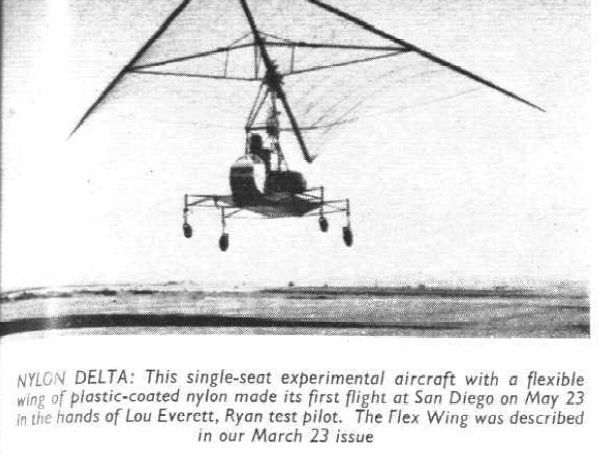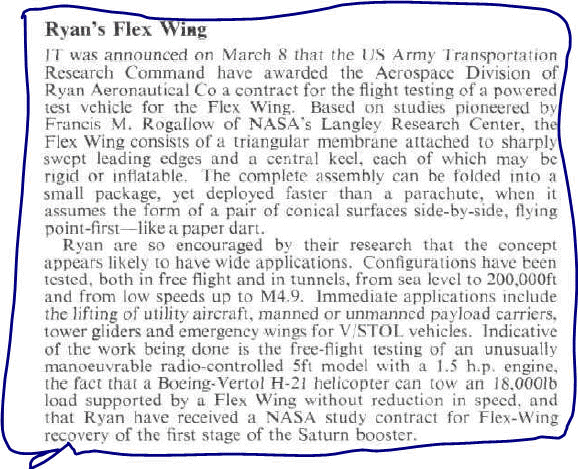|
Flex Bee drone
and associated Ryan working Flex-Wings
Thanks to Tony Prentice for the lead. |
- Discuss with John Worth's work. See
http://www.rogallohanggliders.com
- Notice use of triangle control airframe part and duplicate to help
hold payload.
- Notice the 1961 dates.
- Notice the publication in Flight International, 1 August
1963, pages 170 and following
[ verify]
- "Ryan are making eight Flex-Bees,"
-
http://www.flightglobal.com/pdfarchive/view/1963/1963%20-%201346.html
Flexible Wings at Work, p. 170f
- Fleep
- Flex-Wing photo shows two triangle control frames holding ends
of payload and cockpit. Photo shows truss cross-bar.
See John Worth works for the hang glider and the A-frame for
payload and balance of the hang gliders.
- M. M. McDaniel, Flex Wing programmes manager
- In the article published in 1 August 1963:
"In 1961 the Ryan Aeronautical Co, of San Diego 12, Calif,
started full-scale flight tests with the first Flex-Wing aircraft,
to demonstrate the feasibility of the idea. The idea was not
new, but Ryan was the first to put it into practice: to build an
aeroplane with a wing consisting of a delta-shaped flexible, plastics
covered
sheet attached to a rigid leading edge and centreline. Under load the
sheet billows out into port and starboard planes
each forming part of the surface of a cone. Such a wing has no
proper aerofoil section; in fact it is essentially two-dimensional.
But it is light and cheap, and for many specialist tasks appears
superior to a conventional "rigid" aerofoil. Aircraft control is
accomplished not by aerodynamic reaction on movable surfaces
but by displacing the suspended-body e.g. position relative to the
wing.
During the latter part of 1961 Ryan were content to carry on
proving the principle, which the company call the Flex-Wing.
This journal asked Ryan to outline the origin of the idea, and the
company replied, "I guess this Flex-Wing concept was originally
toyed with by Leonardo da Vinci—it seems he had a hand in every
revolutionary concept. There are also evidences that Otto Lilienthal
had a hang glider concept which was close to the Flex-Wing
idea.
Ryan have used light-alloy structures and a variety of covering
materials. Ordinary rip-stock parachute nylon is common, or nylon
or Dacron covered with a plastic film to increase strength and reduce
porosity. These materials weigh from l oz to 6 oz per square yard,
and stand up excellently to repeated folding and general use. The
control mechanism shifts the position of the hung body relative to
the wing by reeling in and out the suspension lines on electromechanical
winches.
The original free-flight,
full-scale test vehicle was a manned
one. It was piloted by
company chief engineering test pilot Lou
Everett, who found little difficulty in acquiring the special
techniques
needed to obtain the best results from such a concept.
Once Everett had shown that the Flex-Wing could be flown, he
undertook an intensive test programme for the US Army Transportation
Research Command (TRECOM), at Brown Field, just
south of San Diego. The same craft was then shipped to the National
Aeronautics and Space Administration Langley Research
Center, in Virginia, where tests in Mr. Rogallo's big open-jet tunnel
confirmed data obtained in free
flight.
Ryan have thought of many Flex-Wing applications. Some
appear improbable, or at least not capable of immediate realization.
But during the past year a very encouraging number of these
potential applications have become the subject of US Government
contracts, including the following:—
1. Atmospheric recovery, following re-entry, of the NASA/Department
of Defense Gemini two-man Earth orbiter (responsibility for this
part of the Gemini programme was not assigned to Ryan).
2. PDG (precision-drop glider) system for the US Army, using
Flex-Wings to support cargo containers released from transport aircraft
and remotely controlled to land on preselected spots.
3. ACD (air cargo delivery) system for the US Army, using Flex-
Wings to support gliders towed by helicopters.
4. Fleep (a corruption of "Flex-Wing" and "Jeep") for the US Army
TRECOM, using Flex-Wings to carry payloads in support of forward
troops.
5. Flex-Bee (a name stemming from the company's very successful
Firebee), for the US Marine Corps, using Flex-Wings to support an
unmanned reconnaissance package.
The last-named appears of doubtful value, since at first sight ..."
... "Like all Flex-Wing applications, the PDG has been constructed
entirely of standard off-the-shelf hardware and electronics
subassemblies.
This has assisted greatly in minimizing cost, and is
also partly responsible for the very high degree of reliability which
is being achieved even at this early stage."
ETC.
worth a good reading and study; see full article.
- Lou Everett may be enshrined as a hang glider pilot of Flex-Wing in
free-flight. This may or may have been before or after Tony Prentice's
age-13 flex-wing make and jump in 1960..
-
http://farm6.staticflickr.com/5106/5685105310_5e9d14c8ba_z.jpg
|
See:
http://www.flightglobal.com/pdfarchive/view/1961/1961%20-%200723.html
Flight 1 June 1961. On May 23, 1961 (Otto
Lilienthal's birthday) ... the article notes the maiden flight of
the shown "Nylon Delta" device piloted by Lou Everett.
See FLIGHT' 23 March,
1961 issue for some coverage of the Flex-Wing:
Ryan's Flex Wing
IT was announced on March 8 that the US Army Transportation
Research Command have awarded the Aerospace Division of
Ryan Aeronautical Co a contract for the flight testing of a powered
test vehicle for the Flex Wing. Based on studies pioneered by
Francis M. Rogallow (sic,
Rogallo) of NASA's Langley
Research Center, the
Flex Wing consists of a triangular membrane attached to sharply
swept leading edges and a central keel, each of which may be
rigid or inflatable. The complete assembly can be folded into a
small package, yet deployed faster than a parachute, when it
assumes the form of a pair of conical surfaces side-by-side, flying
point-first—like a paper dart.
Ryan are so encouraged by their research that the concept
appears likely to have wide applications. Configurations have been
tested, both in free flight and in tunnels, from sea level to 200,000ft
and from low speeds up to M4.9. Immediate applications include
the lifting of utility aircraft, manned or unmanned payload carriers,
tower gliders and emergency wings for V/STOL vehicles. Indicative
of the work being done is the free-flight testing of an unusually
manoeuvrable radio-controlled 5ft model with a 1.5 h.p. engine,
the fact that a Boeing-Vertol H-21 helicopter can tow an 18,0001b
load supported by a Flex Wing without reduction in speed, and
that Ryan have received a NASA study contract for Flex-Wing
recovery of the first stage of the Saturn booster. |
|
"Ryan showed a control-line '"flex-wing" model flying
round and round the salesman on the company stand." Page
_____ showing article "Sights of New York" by Kenneth Owen in
FLIGHT magazine in issue 9 November, 1961. New York Coliseum
show: "both to professionals and to the general public, the show was a
mixture of technical interest and fairground gimmicks, wrapped together in
glossy brochurity and tied with a Madison Avenue giftwrap bow. Expected or
not, the overall effect was startling."
PDG Precision Drop Glider "Air Cargo Tow Glider is what
Ryan call this application
of the flexible wing to a simple pilotless cargo carrier
towed behind a helicopter (in this case a Sikorsky H-34).
Gross weights of up to 1,1001b have been successfully
flown, and an 8,0001b figure is envisaged. Released from
the tow, the glider can be homed—by an automatic beacon,
or by a manned transmitter either on the ground or the
tug aircraft—to the required landing site. As the glider
nears touchdown, a sensor cable hanging below it actuates
a mechanism which increases wing angle-of-attack and a
consequent flare-out to a gentle landing. The glider can
also be landed while still under tow." ... in a recap later in Oct.
1963 article.
Air Cargo Tow Glider
Flex-Bee "Flex Bee is the reconnaissance drone first
developed for the US Marine
Corps in 1961 and now under test at Yuma. Launched at 40 m.p.h.
by a propellent charge from this simple portable launcher, it can cruise
at 65 m.p.h. on the power of its 9 ½ h.p.
McCullough go-kart engine.
A range of "several miles" at up to 5,000ft has been mentioned."
http://farm6.staticflickr.com/5106/5685105310_5e9d14c8ba_z.jpg
Ryan Flex Bee in San Diego museum
Ryan XV-8
|

Clip from the June 1, 1961, issue
of FLIGHT.
Source:
http://www.flightglobal.com/pdfarchive/view/1961/1961%20-%200723.html

Notice how very much work was done PRIOR TO THE CONTRACT DATE on the
hang glider wing.
Look into John Worth's contributions to the whole flow. And the work of
Effinger, Struck, Craigo and others on the hang glider wing. |
1961 05 23 Otto Lilienthal birthday: San Diego first flight by Lou
Everett, Ryan test pilot. Four-boom hang glider wing powered payload.
1961 03 08 Contract over a matured hang glider wing for powered research:
Ryan Aeronautical wins contract. March
8, 1961. |
|
Silly-but-interesting history:
After the A-frame was deep history for hang gliders (prior
to 1910 even) and aircraft, even exactly simply cable-stayed with payload
or pilot hung from keel, and after profound worldwide extant show of the
NASA-Rogallo-Ryan hang gliders of hundreds of variations, some tinkerers
would try to claim mechanical invention globally late in the history for
hang gliders. Such silly invention claimers spice aviation history in many
ways; the tinkerers confuse his or her local-personal-breakthroughs with
global already-extant arts available to those skilled in the arts.
Even the FAI got fooled by some pushes of untenable claims for
Johnny-come-late-invention claiming; FAI did not do their homework or did
not care to check for statements' validities.
~JpF |

